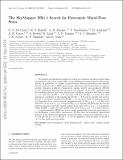Notice
This is not the latest version of this item. The latest version can be found at:https://dspace.mit.edu/handle/1721.1/132434.2
The SkyMapper DR1.1 search for extremely metal-poor stars
| dc.contributor.author | Da Costa, GS | |
| dc.contributor.author | Bessell, MS | |
| dc.contributor.author | Mackey, AD | |
| dc.contributor.author | Nordlander, T | |
| dc.contributor.author | Asplund, M | |
| dc.contributor.author | Casey, AR | |
| dc.contributor.author | Frebel, A | |
| dc.contributor.author | Lind, K | |
| dc.contributor.author | Marino, AF | |
| dc.contributor.author | Murphy, SJ | |
| dc.contributor.author | Norris, JE | |
| dc.contributor.author | Schmidt, BP | |
| dc.contributor.author | Yong, D | |
| dc.date.accessioned | 2021-09-20T18:22:21Z | |
| dc.date.available | 2021-09-20T18:22:21Z | |
| dc.identifier.uri | https://hdl.handle.net/1721.1/132434 | |
| dc.description.abstract | © 2019 The Author(s) Published by Oxford University Press on behalf of the Royal Astronomical Society. We present and discuss the results of a search for extremely metal-poor stars based on photometry from data release DR1.1 of the SkyMapper imaging survey of the southern sky. In particular, we outline our photometric selection procedures and describe the low-resolution (R ≈ 3000) spectroscopic follow-up observations that are used to provide estimates of effective temperature, surface gravity, and metallicity ([Fe/H]) for the candidates. The selection process is very efficient: of the 2618 candidates with low-resolution spectra that have photometric metallicity estimates less than or equal to −2.0, 41 per cent have [Fe/H] ≤ −2.75 and only approximately seven per cent have [Fe/H] > −2.0 dex. The most metal-poor candidate in the sample has [Fe/H] < −4.75 and is notably carbon rich. Except at the lowest metallicities ([Fe/H] < −4), the stars observed spectroscopically are dominated by a ‘carbon-normal’ population with [C/Fe]1D, LTE ≤ +1 dex. Consideration of the A(C)1D, LTE versus [Fe/H]1D, LTE diagram suggests that the current selection process is strongly biased against stars with A(C)1D, LTE > 7.3 (predominantly CEMP-s) while any bias against stars with A(C)1D, LTE < 7.3 and [C/Fe]1D, LTE > +1 (predominantly CEMP-no) is not readily quantifiable given the uncertainty in the SkyMapper v-band DR1.1 photometry. We find that the metallicity distribution function of the observed sample has a power-law slope of ∆(Log N)/∆[Fe/H] = 1.5 ± 0.1 dex per dex for −4.0 ≤ [Fe/H] ≤ −2.75, but appears to drop abruptly at [Fe/H] ≈ −4.2, in line with previous studies. | en_US |
| dc.language.iso | en | |
| dc.publisher | Oxford University Press (OUP) | en_US |
| dc.relation.isversionof | 10.1093/MNRAS/STZ2550 | en_US |
| dc.rights | Creative Commons Attribution-Noncommercial-Share Alike | en_US |
| dc.rights.uri | http://creativecommons.org/licenses/by-nc-sa/4.0/ | en_US |
| dc.source | arXiv | en_US |
| dc.title | The SkyMapper DR1.1 search for extremely metal-poor stars | en_US |
| dc.type | Article | en_US |
| dc.relation.journal | Monthly Notices of the Royal Astronomical Society | en_US |
| dc.eprint.version | Author's final manuscript | en_US |
| dc.type.uri | http://purl.org/eprint/type/JournalArticle | en_US |
| eprint.status | http://purl.org/eprint/status/PeerReviewed | en_US |
| dc.date.updated | 2020-10-23T14:11:01Z | |
| dspace.orderedauthors | Da Costa, GS; Bessell, MS; Mackey, AD; Nordlander, T; Asplund, M; Casey, AR; Frebel, A; Lind, K; Marino, AF; Murphy, SJ; Norris, JE; Schmidt, BP; Yong, D | en_US |
| dspace.date.submission | 2020-10-23T14:11:09Z | |
| mit.journal.volume | 489 | en_US |
| mit.journal.issue | 4 | en_US |
| mit.license | OPEN_ACCESS_POLICY | |
| mit.metadata.status | Authority Work and Publication Information Needed |
